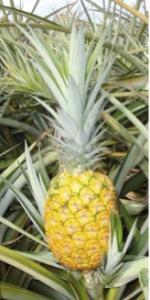UH Manoa researchers help unlock pineapple genome
University of Hawaiʻi at MānoaResearcher, Tropical Plant and Soil Sciences
Nancy Chen, (808) 956-3545
Researcher, Tropical Plant and Soil Sciences
International researchers, including two from UH Mānoa, have taken an important step toward understanding what gives pineapple the ability to thrive in arid conditions where few other crops can survive, and how this knowledge may be used for other crops in drought-stricken areas.
Drs. Nancy Jung Chen and Robert Paull, researchers in Department of Tropical Plant and Soil Sciences (TPSS) in the College of Tropical Agriculture and Human Resources (CTAHR), were part of the international team that has sequenced the genes in the pineapple genome. The team was led by a graduate of TPSS, Dr. Ray Ming, now a professor at the University of Illinois. Dr. Ming’s advisor in TPSS was UH Mānoa's Dr. James Brewbaker, known internationally for his extensive work on corn.
Pineapple has unique traits that have made it a subject of much research. The plant possesses an alternate photosynthetic pathway that concentrates carbon dioxide during the night when water loss is less. This reduced water loss leads to high water-use efficiency. The plant also has a unique flower induction method, which means that plants can be made to flower throughout the year and not only January through May, as was the case when fruit canning was dominant in Hawai‘i. In addition to these practical aspects, the species is of scientific interest as a reference for the evolution of genes in grasses.
The paper reporting the results of this international sequencing effort appeared in the latest online issue of Nature Genetics (http://dx.doi.org/10.1038/ng.3435). The genomes of pineapple varieties ‘F153,’ an older canning variety, and ‘MD2,’ a new low-acid hybrid, as well as a wild pineapple relative were sequenced and the genes characterized. The role of Drs. Paull and Chen in this project was in the characterization of the genes involved in sugar and cell-wall metabolism.
Pineapple (Ananas comosus (L.) Merr.) is the only member of the Bromeliad family, which includes many ornamental plants, that produces an edible fruit. In world trade, pineapple is the second most important tropical fruit after bananas, grown widely throughout the tropics. The two most important fresh fruit varieties of pineapple worldwide were developed by the Hawaiʻi Pineapple Research Institute’s plant breeders in the 1970s and widely commercialized in the late 1990s.
The pineapple genome has 24,063 full-gene models and about 3,000 partial models. This gene number is slightly higher than the number of genes found in papaya. The genome has one fewer of the ancient whole-genome duplications than are found in other sequenced grass genomes. This lack of genome duplications provides an important reference for elucidating gene content and structure in the last common ancestor of the grass family.
Current efforts in this project involve collaboration with Australian researchers to complete the characterization of the pineapple genes involved in sugar metabolism and cell-wall modification. Work is already under way to use the sequencing data to determine how flowering is controlled in pineapple. Drs. Chen and Paull were previously involved in the international sequencing efforts for papaya, Asian pear and sacred lotus.
For more information, visit: http://www.ctahr.hawaii.edu



